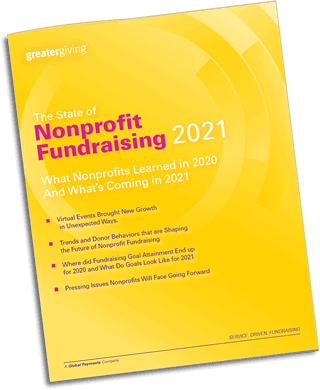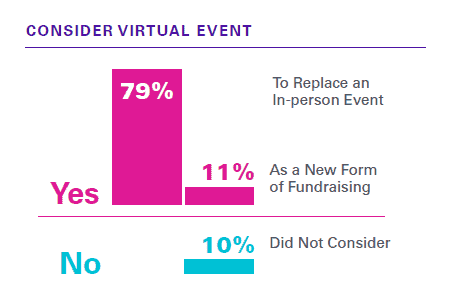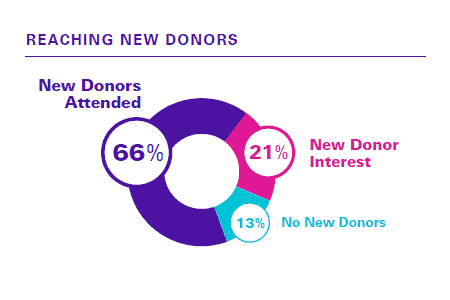
Virtual Events in a Post-COVID Future
The onset of COVID-19—and the resulting restrictions on large gatherings—necessitated a very quick pivot away from traditional fundraising galas and in-person events. Nonprofits were presented with a choice: no events at all, or figure out how to hold one virtually so guests could participate from any device, anywhere they were.
It was a huge challenge, and only 20% of respondents to our State of Nonprofit Fundraising report felt prepared enough to shift seamlessly to online-only. Most nonprofits canceled or postponed their live fundraising events, then dove headfirst into coming up with alternatives to still meet their fundraising goals.
Virtual Fundraisers Opened New Doors
Luckily, most nonprofits had already implemented some form of online giving to support their year-round capital campaigns, one-time donations and recurring donations—the seeds of the virtual event were there.
Nonprofits researched livestreaming platforms, adjusted sponsorship packages and benefits, and tried to design event programs that would engage guests in front of their computer screen. More than half (58%) of nonprofits surveyed for The State of Nonprofit Fundraising reported virtual events were an important fundraising activity for them in 2020.
There were struggles and successes. Nonprofits discovered that virtual events allowed them to reach more people than ever before, and 88% of those surveyed saw interest from new donors. Despite the challenges, there was a silver lining in the move to purely online fundraisers: a more accessible event meant a wider reach, more donors, and more fundraising. A majority of survey respondents rated “Ticket sales and memberships” as an insignificant—or even nonexistent—fundraising activity last year, suggesting that many organizations didn’t charge admission to their virtual events. And a lower barrier to entry means more people are able to join in.
Challenges to “Virtual Only”
Virtual fundraisers presented significant obstacles to organizers—some that may not be solved with more practice or expertise.
1. Guest engagement. How do you keep people excited to participate and donate when they’re staring at a screen at home?
2. Production. Many nonprofits struggled to wrangle new technology platforms into a program that would keep people tuned in and donations coming, and production companies could be costly.
3. Sponsors. Sponsorships and major gifts are the lifeblood of many nonprofit fundraising events—but without being able to sell tables at in-person events, benefits and recognition for sponsors changed fundamentally. Nonprofits rated sponsorship packages and promotions the most desirable element in future virtual events, suggesting that the ability to woo sponsors is more important than ever.
Will We See Virtual Fundraisers in 2021 and Beyond?
While many nonprofits saw successes with purely virtual events, more than half still fell short of their fundraising goals. Some of the obstacles they faced may not be solved with higher production value or more practice; there are simply elements of a live event that can’t be simulated.
At the same time, half of The State of Nonprofit Fundraising survey respondents said they planned to host a virtual or hybrid gala in the coming year, and an enormous number of respondents see virtual events and tours as critical fundraising activities. Online events became a critical component of fundraising in 2020 and revealed new outreach opportunities—and that’s not going away soon!
While we may not see big fundraising galas with 400 attendees return instantly as COVID-19 loosens its hold, we may see some small, controlled events appear, with limited capacity to allow social distancing. And nonprofits will likely utilize whatever in-person options they have available to better engage guests, donors and sponsors. No one knows exactly what this will look like, but we have some guesses.
The “Hybrid” Live and Virtual Event
When we found that “a mobile-optimized experience” was the second-highest most desirable feature in a virtual event, it provided a snapshot of what future hybrid events may and could look like. Online bidding, donating, and other forms of fundraising through mobile devices have already existed as a part of many live events for some time. Bidders who couldn’t be present for a live event could still bid on silent auction items from home, creating even more competition and driving up final sale prices.
Imagine an event where sponsors and their guests sit at tables and eat dinner during the program, while bidders at home can watch right along with them—donating from mobile devices at their own dining room tables, and participating in the live auction alongside in-person guests bidding with paddles.
The fancy charity gala doesn’t have to be only for those who can afford a ticket. A wider audience means a wider pool of potential donors, and we’ve seen in the last year how many small, individual donors can make great contributions.
“Hybrid” events will take on many forms, just as every nonprofit has their own unique approach to fundraising events. But virtual fundraising has shown its power and potential, and smart fundraisers will seize the opportunity.
